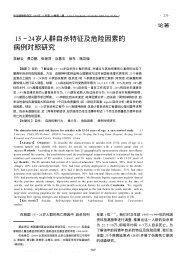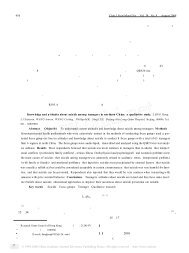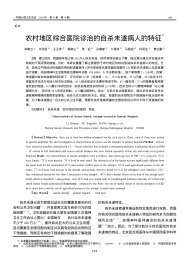Attitudes Toward Suicide Among Chinese People in Hong Kong
Attitudes Toward Suicide Among Chinese People in Hong Kong
Attitudes Toward Suicide Among Chinese People in Hong Kong
Create successful ePaper yourself
Turn your PDF publications into a flip-book with our unique Google optimized e-Paper software.
574 <strong>Attitudes</strong> <strong>Toward</strong> <strong>Suicide</strong> <strong>in</strong> <strong>Hong</strong> <strong>Kong</strong><br />
behavior. This tallied with our f<strong>in</strong>d<strong>in</strong>g that tud<strong>in</strong>al complexity of suicide may navigate<br />
respondents who were classified under hypo- different forms of prevention efforts to more<br />
thetical scenarios as be<strong>in</strong>g high risk had more<br />
suicidal ideation, made previous suicide at-<br />
realistic goals.<br />
tempts, and demonstrated a more positive<br />
appraisal of suicide than their respective<br />
Limitations and Future Research<br />
comparison groups. The present study has several limitations<br />
that suggest the need for further re-<br />
Implications for <strong>Suicide</strong> Prevention search. First, the f<strong>in</strong>d<strong>in</strong>gs from a convenience<br />
sample clearly cannot be generalized to the<br />
Phillips, Liu, and Zhang (1999) sug- general population <strong>in</strong> <strong>Hong</strong> <strong>Kong</strong> or other<br />
gested five <strong>in</strong>teract<strong>in</strong>g factors that collec- <strong>Ch<strong>in</strong>ese</strong> communities. The low variance extively<br />
determ<strong>in</strong>ed suicide rates <strong>in</strong> a commupla<strong>in</strong>ed by the identified factors could, for exnity.<br />
These <strong>in</strong>cluded cultural attitudes toward ample, be due to sampl<strong>in</strong>g bias toward pro-<br />
suicide <strong>in</strong> addition to the prevalence of social ductive members of society (namely, employees<br />
and mental health problems, convenience of and students). Future studies should encommethods<br />
of suicide, and comprehensiveness pass a general population sample that <strong>in</strong>-<br />
of suicide prevention services. While <strong>in</strong>tu- cludes socially disadvantaged people who<br />
itively plausible, these five factors are not eas- may be more prone to endorse suicide. Secily<br />
modifiable, especially by cl<strong>in</strong>icians. In the ond, attitudes do not necessarily translate<br />
case of <strong>Hong</strong> <strong>Kong</strong>, there is little popula- <strong>in</strong>to behavior <strong>in</strong> accordance with the multition-based<br />
public health policy that addresses factor model of suicide (Manstead, 1996). At-<br />
the treatment gap of mental disorders, not to titudes must <strong>in</strong>teract among themselves and<br />
speak of their prevention. Widely believed to with non-attitud<strong>in</strong>al factors <strong>in</strong> their ultimate<br />
be gatekeepers, primary care practitioners are impact on behavior. As such, our f<strong>in</strong>d<strong>in</strong>gs<br />
<strong>in</strong>adequately tra<strong>in</strong>ed to manage common should be <strong>in</strong>terpreted cautiously. Third, the<br />
mental disorders (Lee, Tsang, & Kwok, CASQ-HK was lengthy and, because of our<br />
2007). The most common methods of suicide failure to secure consent from the partici-<br />
<strong>in</strong> <strong>Hong</strong> <strong>Kong</strong>—jump<strong>in</strong>g from height and pants for a second round of distribution, its<br />
charcoal burn<strong>in</strong>g (Centre for <strong>Suicide</strong> test-retest reliability was not established.<br />
Research and Prevention, 2005)—are hardly Shorten<strong>in</strong>g it will allow larger samples of<br />
controllable. Moreover, suicide prevention people to be exam<strong>in</strong>ed and a more str<strong>in</strong>gent<br />
efforts are not only limited <strong>in</strong> quantity but assessment of its psychometric properties. Fi-<br />
also have adopted methods (e.g., hotl<strong>in</strong>e nally, we believe that attitud<strong>in</strong>al surveys fail<br />
counsel<strong>in</strong>g by volunteers and advice to jour- to uncover the layers of privacy and equivonalists<br />
on appropriate ways of report<strong>in</strong>g sui- cality that typically envelop suicide. They<br />
cide) that are of questionable usefulness. In should be complemented by ethnographic<br />
regards to the f<strong>in</strong>d<strong>in</strong>gs of the present study, research that elucidates the complex <strong>in</strong>terac-<br />
we are still uncerta<strong>in</strong> about how attitudes and tions of attitudes and behaviors <strong>in</strong> specific<br />
contextual factors act <strong>in</strong> concert to evoke sui- contexts and how large-scale socioeconomic<br />
cide, and how attitud<strong>in</strong>al data can be <strong>in</strong>te- transformations <strong>in</strong> <strong>Ch<strong>in</strong>ese</strong> society shape the<br />
grated <strong>in</strong>to health <strong>in</strong>terventions to reduce <strong>in</strong>ter-subjective mean<strong>in</strong>gs of suicide (Lee &<br />
suicide. Nonetheless, acknowledg<strong>in</strong>g the atti- Kle<strong>in</strong>man, 2005).<br />
REFERENCES<br />
Census and Statistics Department of<br />
HKSAR. (2004). Women and men <strong>in</strong> <strong>Hong</strong> <strong>Kong</strong>—<br />
vention. (2005). Research f<strong>in</strong>d<strong>in</strong>gs <strong>in</strong>to suicide and<br />
its prevention. <strong>Hong</strong> <strong>Kong</strong>: University of <strong>Hong</strong><br />
Key statistics. <strong>Hong</strong> <strong>Kong</strong>: Author. <strong>Kong</strong>.<br />
Centre for <strong>Suicide</strong> Research and Pre-<br />
Goldsmith, S. K., Pellmar, T. C., Kle<strong>in</strong>-<br />
500
















